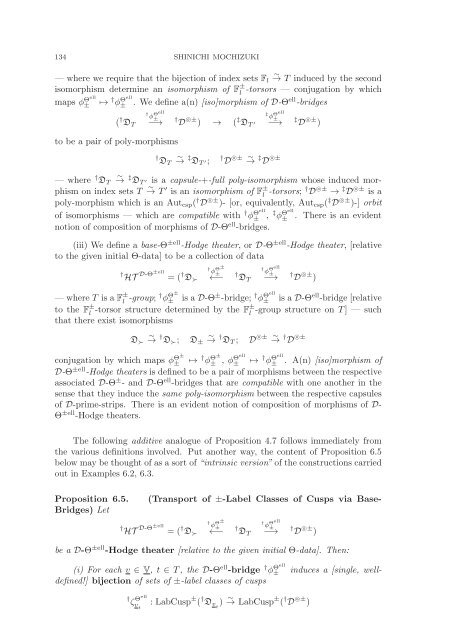Inter-universal Teichmuller Theory I: Construction of Hodge Theaters
Inter-universal Teichmuller Theory I: Construction of Hodge Theaters
Inter-universal Teichmuller Theory I: Construction of Hodge Theaters
Create successful ePaper yourself
Turn your PDF publications into a flip-book with our unique Google optimized e-Paper software.
134 SHINICHI MOCHIZUKI<br />
∼<br />
— where we require that the bijection <strong>of</strong> index sets F l → T induced by the second<br />
isomorphism determine an isomorphism <strong>of</strong> F ± l<br />
-torsors — conjugation by which<br />
maps φ Θell<br />
± ↦→ † φ Θell<br />
± . We define a(n) [iso]morphism <strong>of</strong> D-Θ ell -bridges<br />
( † † φ Θell<br />
±<br />
D T −→ † D ⊚± ) → ( ‡ D T<br />
′<br />
to be a pair <strong>of</strong> poly-morphisms<br />
‡ φ Θell<br />
±<br />
−→ ‡ D ⊚± )<br />
† D T<br />
∼<br />
→ ‡ D T ′;<br />
† D ⊚± ∼<br />
→ ‡ D ⊚±<br />
—where † ∼<br />
D T → ‡ D T<br />
′ is a capsule-+-full poly-isomorphism whose induced morphism<br />
on index sets T → ∼ T ′ is an isomorphism <strong>of</strong> F ± l -torsors; † D ⊚± → ‡ D ⊚± is a<br />
poly-morphism which is an Aut csp ( † D ⊚± )- [or, equivalently, Aut csp ( ‡ D ⊚± )-] orbit<br />
<strong>of</strong> isomorphisms — which are compatible with † φ Θell<br />
± , ‡ φ Θell<br />
± . There is an evident<br />
notion <strong>of</strong> composition <strong>of</strong> morphisms <strong>of</strong> D-Θ ell -bridges.<br />
(iii) We define a base-Θ ±ell -<strong>Hodge</strong> theater, orD-Θ ±ell -<strong>Hodge</strong> theater, [relative<br />
to the given initial Θ-data] to be a collection <strong>of</strong> data<br />
† HT D-Θ±ell =( † † φ Θ±<br />
±<br />
D ≻ ←− † † φ Θell<br />
±<br />
D T −→ † D ⊚± )<br />
—whereT is a F ± l -group; † φ Θ±<br />
± is a D-Θ ± -bridge; † φ Θell<br />
± is a D-Θ ell -bridge [relative<br />
to the F ± l -torsor structure determined by the F± l<br />
-group structure on T ]—such<br />
that there exist isomorphisms<br />
D ≻<br />
∼<br />
→ † D ≻ ; D ±<br />
∼<br />
→ † D T ; D ⊚± ∼<br />
→ † D ⊚±<br />
conjugation by which maps φ Θ±<br />
± ↦→ † φ Θ±<br />
± , φ Θell<br />
± ↦→ † φ Θell<br />
± . A(n) [iso]morphism <strong>of</strong><br />
D-Θ ±ell -<strong>Hodge</strong> theaters is defined to be a pair <strong>of</strong> morphisms between the respective<br />
associated D-Θ ± -andD-Θ ell -bridges that are compatible with one another in the<br />
sense that they induce the same poly-isomorphism between the respective capsules<br />
<strong>of</strong> D-prime-strips. There is an evident notion <strong>of</strong> composition <strong>of</strong> morphisms <strong>of</strong> D-<br />
Θ ±ell -<strong>Hodge</strong> theaters.<br />
The following additive analogue <strong>of</strong> Proposition 4.7 follows immediately from<br />
the various definitions involved. Put another way, the content <strong>of</strong> Proposition 6.5<br />
below may be thought <strong>of</strong> as a sort <strong>of</strong> “intrinsic version” <strong>of</strong> the constructions carried<br />
out in Examples 6.2, 6.3.<br />
Proposition 6.5.<br />
Bridges) Let<br />
(Transport <strong>of</strong> ±-Label Classes <strong>of</strong> Cusps via Base-<br />
† HT D-Θ±ell =( † † φ Θ±<br />
±<br />
D ≻ ←− † † φ Θell<br />
±<br />
D T −→ † D ⊚± )<br />
be a D-Θ ±ell -<strong>Hodge</strong> theater [relative to the given initial Θ-data]. Then:<br />
(i) For each v ∈ V, t ∈ T ,theD-Θ ell -bridge † φ Θell<br />
± induces a [single, welldefined!]<br />
bijection <strong>of</strong> sets <strong>of</strong> ±-label classes <strong>of</strong> cusps<br />
† ζ Θell<br />
v t<br />
: LabCusp ± ( † D vt ) ∼ → LabCusp ± ( † D ⊚± )
















